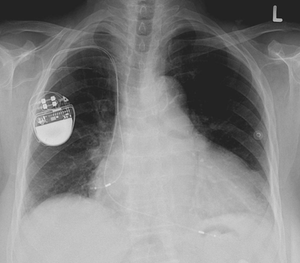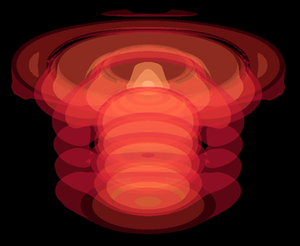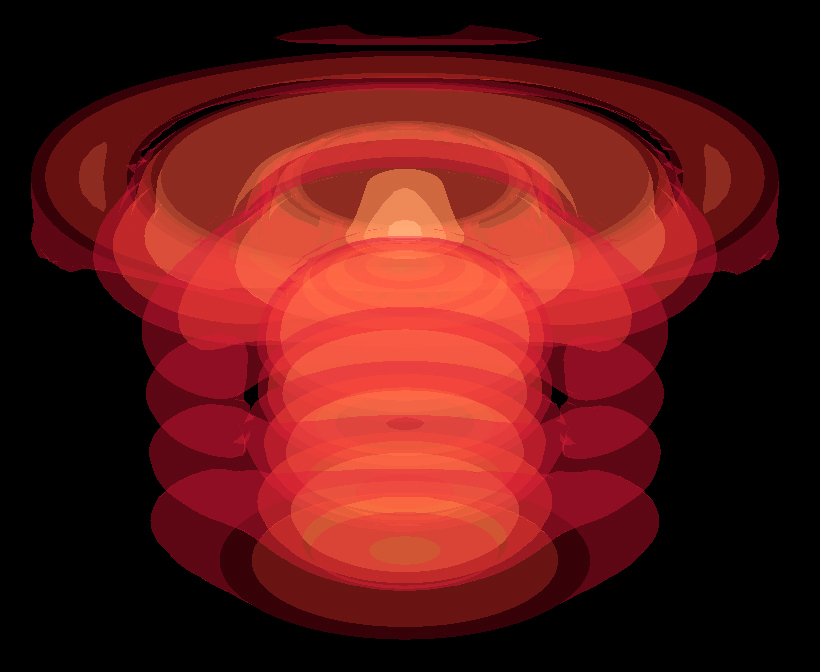Wireless Power for Tiny Medical Devices
Medical electronic implants could be powered wirelessly, without the need for batteries or bulky receiver coils, if an approach described in Physical Review Letters pays off. The researchers propose a new design to allow wireless power transfer to even sub-millimeter-sized devices and show that in theory it should deliver enough power to drive a pacemaker.
Implanted medical devices like pacemakers and defibrillators generally run on batteries, which not only raise safety concerns, but also make them bulky. A few existing devices, such as defibrillators and cochlear implants, are powered by radio-frequency electromagnetic fields, rather than an on-board battery, but they remain bulky because they require a receiver coil a few centimeters across.
The large coil is needed because, instead of relying on “radiating” waves (conventional radio waves), which don’t penetrate well into biological tissue, the systems use so-called evanescent fields. These are short range and don’t extend more than several times the source’s dimensions. So the source must be large enough that its evanescent field will extend to the implanted receiver—but then the receiver must be of a similar size to the source, because otherwise this kind of power transfer is inefficient.
Ada Poon and colleagues at Stanford University in California looked for a way to reduce the size of the receiver, ideally so that implants need be no bigger than a millimeter or so. Such an improvement could also allow more capabilities to be packed into a smaller volume. This battery-free approach could work in situations where “a device turns on when activated by an external source but is otherwise dormant,” says Poon. “These might include stimulators for treating neurological disorders, sensors that are powered during read-out, or locomotive drug-delivery systems that are inside the body for a short time.”
Poon’s team has shown that, despite the issue of tissue absorption, radiating modes can after all be used to boost power transfer—which makes it less necessary to match the size of the source and receiver. Their theoretical analysis shows that, although these radiating modes can’t travel very far without being absorbed, there is an optimal middle ground where both evanescent and radiating modes can deliver power even to a tiny receiver. This “mid-field” regime can be reached by using higher frequencies, in the gigahertz range, rather than the kilohertz to megahertz range of existing technologies.
The calculations that include both evanescent and radiating modes are more challenging than at either of those two extremes. But the researchers were able to carry them out using numerical calculations and some theoretical tools they developed. They looked for the optimal power-transfer modes over a wide range of frequencies, assuming particular source and receiver geometries and typical tissue properties.
As the source frequency increases, the strength of the interaction between the receiver and the magnetic field increases—but so does tissue absorption. Poon says that previously this problem with high frequencies has been considered insurmountable. But she and her colleagues have found that there is a “sweet spot” at which the waves can penetrate deeply enough into the tissue to transfer a significant amount of power. Poon says that these optimal modes exploit interference effects of the radiating waves that focus the field into “hot spots” where the device could be placed.
The researchers calculated that they could get close to the optimum mode using a source consisting of a slotted metal plate—rather than a coil—with several out-of-phase voltages applied to it. They found that, with a wire loop receiver 0.8 millimeters in diameter buried beneath 4 centimeters of tissue, a source power of 250 milliwatts (less than needed for a typical cell phone) can transfer 10 microwatts to a device. This is enough power to operate a pacemaker.
“This work definitely provides food for thought,” says Anil Kumar, a specialist in wireless biomedical technology at the University of Utah. But he cautions that the tissue model used in the authors’ simulation is still too simplistic to represent, say, a chest cavity.
While Poon says that there are no particular advantages of their proposal for charging mobile electronics such as cell phones (for which there are already simpler solutions), their approach of identifying optimal source fields might be used to design better optical antennas for capturing light, for example in solar energy conversion.
–Philip Ball
Philip Ball is a freelance science writer in London. His latest book is How Life Works (Picador, 2024).







